For architectural visualization, you'll want exceptional high-resolution tools. Consider the Sony Alpha A7R IV or Nikon D850 for stunning detail. The Canon EOS 5DS R excels in sharpness, while the Hasselblad H6D-100c offers unparalleled image quality. For aerial shots, try the DJI Phantom 4 Pro V2.0 or Autel EVO II Pro. The Leica M10 Monochrom captures exquisite black and white images, and the Phase One XT system provides medium format excellence. Don't overlook the Freefly Alta X for heavy-duty aerial work. Each tool has unique strengths to elevate your architectural photography. Explore further to discover which best suits your specific needs.
DJI Phantom 4 Pro V2.0
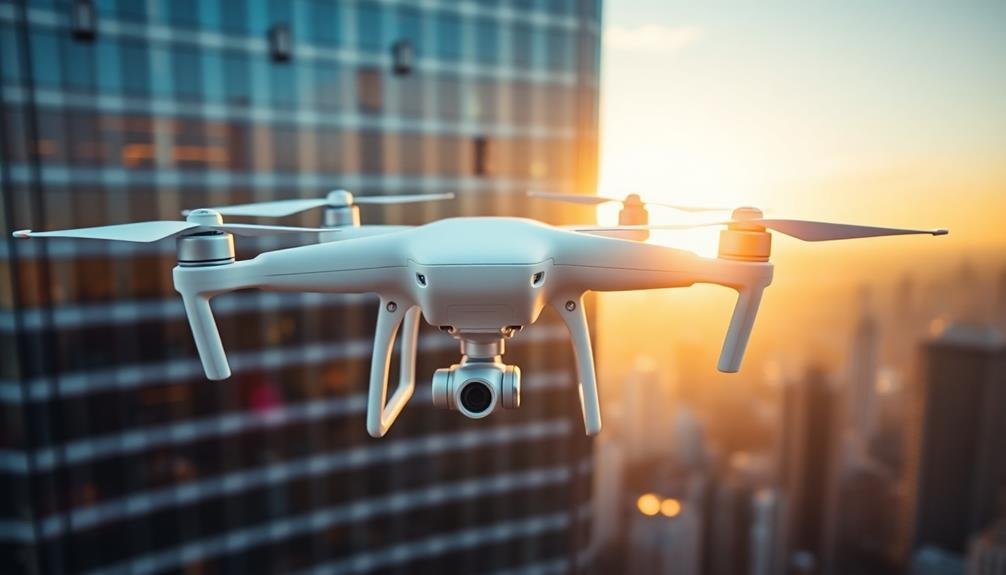
One of the top choices for aerial architectural photography is the DJI Phantom 4 Pro V2.0. This drone's 20-megapixel camera with a 1-inch sensor captures stunning high-resolution images, perfect for showcasing architectural projects from unique angles.
You'll appreciate its ability to shoot 4K video at 60fps, providing smooth footage for dynamic visual presentations.
The Phantom 4 Pro V2.0 boasts an impressive 30-minute flight time, giving you ample opportunity to capture multiple shots and angles during a single session. Its obstacle avoidance system utilizes sensors on all sides, ensuring safe operation around buildings and structures.
You'll find the drone easy to control with its intuitive remote and smartphone app interface.
For architectural visualization, you'll benefit from the drone's intelligent flight modes. These include Point of Interest, which allows you to orbit a building automatically, and Draw mode, letting you create custom flight paths.
The drone's mechanical shutter reduces rolling shutter distortion, essential for capturing straight lines in architecture. With a maximum transmission range of 7km, you can capture expansive cityscapes or isolated structures with ease.
Autel EVO II Pro

Another excellent drone option for architectural photography is the Autel EVO II Pro. This powerful drone boasts a 1-inch CMOS sensor capable of capturing 20MP stills and 6K video, making it ideal for high-resolution architectural visualization.
You'll appreciate its 40-minute flight time, which allows for extended shooting sessions without frequent battery changes. The EVO II Pro's obstacle avoidance system utilizes 12 computer vision sensors, guaranteeing safe operation around buildings and structures.
Its compact, foldable design makes it easily portable to various job sites. You can take advantage of the drone's 7.4-mile transmission range for capturing expansive architectural landscapes.
With features like HDR imaging and adjustable aperture (f/2.8 to f/11), you'll have greater control over exposure and depth of field in your architectural shots. The EVO II Pro's intelligent flight modes, including waypoints and orbit, enable you to capture smooth, cinematic footage of buildings.
Its ability to shoot in 10-bit color provides enhanced color grading possibilities in post-production. For low-light situations, the EVO II Pro's ISO range of 100-12,800 guarantees you can still capture clear, detailed images of architectural projects.
Sony Alpha A7R IV

The Sony Alpha A7R IV stands as a top-tier full-frame mirrorless camera for architectural photography. Its 61-megapixel sensor delivers unparalleled image quality, capturing intricate details of buildings and interiors.
You'll appreciate the camera's 15-stop dynamic range, which allows you to capture both bright highlights and deep shadows in challenging lighting conditions.
The A7R IV's 5-axis in-body image stabilization system helps you maintain sharpness when shooting handheld, especially useful in low-light situations or when using longer focal lengths. Its advanced autofocus system, with 567 phase-detection points, guarantees your architectural subjects remain crisp and in focus.
You'll find the camera's weather-sealed body ideal for outdoor shoots, protecting against dust and moisture. The high-resolution electronic viewfinder and tilting touchscreen make composition and reviewing images a breeze.
With dual UHS-II SD card slots, you can backup your valuable shots instantly.
For architectural visualization, you'll benefit from the A7R IV's pixel shift multi-shooting mode, which combines multiple images to create ultra-high-resolution 240-megapixel files. This feature is perfect for capturing minute details in textures and materials.
The camera's Wi-Fi and Bluetooth connectivity allow for quick image transfer and remote control, streamlining your workflow on location.
Nikon D850 DSLR Camera
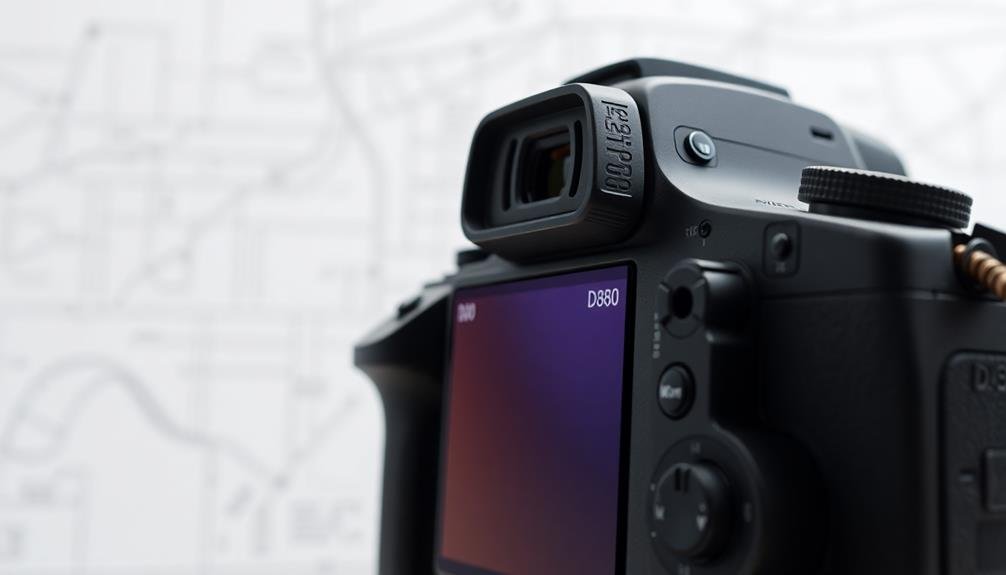
You'll find the Nikon D850 DSLR camera to be a powerhouse for architectural visualization.
Its exceptional image quality stems from a high-resolution full-frame sensor, capturing intricate details with stunning clarity.
The camera's advanced autofocus capabilities guarantee you'll never miss a vital architectural element, even in challenging lighting conditions.
Exceptional Image Quality
When it comes to capturing architectural details with stunning clarity, the Nikon D850 DSLR camera stands out as a top choice. Its exceptional image quality is a result of its impressive 45.7-megapixel sensor, which allows you to capture every intricate detail of a building's structure. You'll be able to produce large, high-resolution prints or crop images without sacrificing quality.
The D850's dynamic range is another standout feature, enabling you to capture both highlights and shadows in challenging lighting conditions often encountered in architectural photography. You'll appreciate the camera's ability to render textures, materials, and subtle color variations with remarkable accuracy.
Here's a breakdown of the D850's key image quality features:
| Feature | Benefit |
|---|---|
| 45.7MP sensor | Ultra-high resolution |
| 64-25600 ISO range | Excellent low-light performance |
| 14-bit RAW files | Greater editing flexibility |
| No optical low-pass filter | Enhanced sharpness and detail |
With these capabilities, you'll be able to produce images that showcase architectural designs in their best light, capturing the essence of structures with unparalleled clarity and precision. The D850's exceptional image quality makes it an invaluable tool for architectural visualization professionals.
High-Resolution Full-Frame Sensor
Diving deeper into the Nikon D850's standout feature, its high-resolution full-frame sensor sets a new standard for architectural photography. With a whopping 45.7 megapixels, this sensor captures intricate details that are essential for showcasing architectural designs.
You'll be able to render textures, patterns, and fine lines with exceptional clarity, allowing viewers to appreciate the nuances of building materials and structural elements.
The full-frame sensor also excels in low-light situations, which is particularly useful when photographing interiors or evening exteriors. You'll achieve cleaner images with less noise, even at higher ISO settings.
This sensor's dynamic range is impressive, letting you capture both bright highlights and deep shadows in a single shot, perfect for balancing bright windows with darker interior spaces.
Moreover, the D850's sensor facilitates large-scale prints and extensive cropping without compromising image quality. You can zoom in on specific architectural features or create expansive panoramas while maintaining sharpness and detail.
This versatility is invaluable when you need to adapt your shots for various presentation formats or client requirements.
Advanced Autofocus Capabilities
While the high-resolution sensor is impressive, the Nikon D850's advanced autofocus capabilities truly set it apart for architectural photography. You'll find its 153-point autofocus system with 99 cross-type sensors incredibly responsive, even in low-light conditions. This means you can capture sharp images of intricate architectural details, regardless of the lighting situation.
The D850's autofocus system offers several modes to suit different architectural shooting scenarios:
- Group-area AF: Perfect for focusing on specific building elements
- 3D-tracking: Ideal for following moving subjects in dynamic urban environments
- Auto-area AF: Great for capturing wide cityscapes or building exteriors
You'll appreciate the camera's ability to lock onto subjects quickly and accurately, ensuring that every architectural line and texture is crisp and well-defined.
The D850's focus tracking is particularly useful when shooting in busy urban environments, allowing you to maintain focus on your chosen subject even as people or vehicles move through the frame.
With its advanced autofocus capabilities, you'll be able to capture stunning architectural images with ease, whether you're shooting interiors, exteriors, or detailed close-ups of building features.
Canon EOS 5DS R
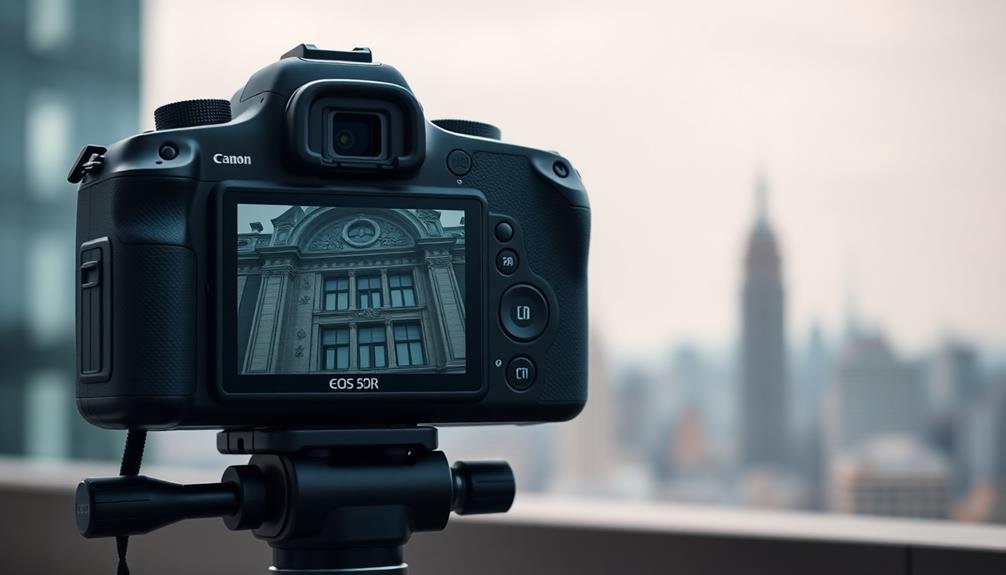
You'll find the Canon EOS 5DS R to be a powerhouse for architectural photography with its exceptional resolution capabilities.
This camera boasts a 50.6-megapixel full-frame CMOS sensor, allowing you to capture intricate details in buildings and landscapes.
The removal of the low-pass filter enhances sharpness and detail even further, giving you the ability to produce stunningly crisp images for your architectural visualizations.
Unparalleled Resolution Capabilities
The Canon EOS 5DS R stands out with its staggering 50.6-megapixel full-frame CMOS sensor, offering unmatched resolution for architectural photography.
You'll capture intricate details of buildings, from the smallest textures to the grandest facades, with exceptional clarity. This camera's ability to produce large-scale prints without losing quality makes it ideal for showcasing your architectural projects in impressive detail.
The EOS 5DS R's low-pass filter cancellation further enhances sharpness, allowing you to record the finest details in your architectural subjects.
You'll appreciate the camera's dual DIGIC 6 image processors, which enable fast processing of these massive image files, ensuring you can work efficiently even with high-resolution shots.
To make the most of the Canon EOS 5DS R's resolution capabilities:
- Use a sturdy tripod to eliminate camera shake
- Opt for high-quality lenses to match the sensor's resolving power
- Shoot in RAW format to preserve maximum detail for post-processing
With its unparalleled resolution capabilities, the Canon EOS 5DS R empowers you to create breathtaking architectural visualizations that showcase every nuance of your subjects, from expansive cityscapes to intricate building details.
Low-Pass Filter Removal
For years, photographers have debated the merits of removing the low-pass filter in digital cameras. The Canon EOS 5DS R, a high-resolution powerhouse, offers this feature, giving you the ability to capture incredibly sharp images. By eliminating the low-pass filter, you'll notice a significant increase in image detail and clarity, especially when shooting architectural subjects.
Without the filter, you'll be able to resolve fine textures, intricate patterns, and subtle details in building facades, interiors, and landscaping elements. This level of sharpness is particularly valuable when creating large-scale prints or when you need to zoom in on specific areas of an architectural rendering.
However, you should be aware that removing the low-pass filter can increase the risk of moiré patterns in some situations, particularly when photographing repetitive patterns or textures.
To make the most of the 5DS R's filterless sensor, you'll need to use high-quality lenses and proper shooting techniques. Pay close attention to your focus, use a sturdy tripod, and consider using mirror lock-up or live view to minimize camera shake.
With these precautions, you'll be able to fully exploit the camera's exceptional resolving power for your architectural visualization projects.
DJI Mavic 3 Pro
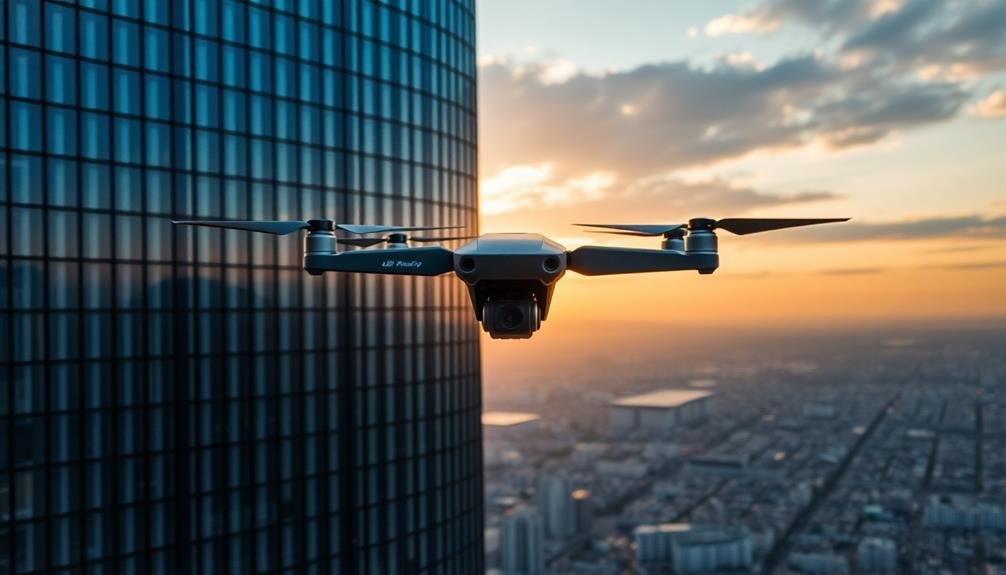
When it comes to capturing breathtaking aerial shots of architectural marvels, the DJI Mavic 3 Pro stands out as a game-changer. This compact drone packs a powerful punch with its dual-camera system, featuring a 4/3 CMOS Hasselblad camera and a 1/2-inch CMOS telephoto camera.
You'll be able to capture stunning 20MP stills and 5.1K video, perfect for showcasing intricate architectural details from unique perspectives.
The Mavic 3 Pro's advanced obstacle avoidance system and intelligent flight modes make it easy to navigate around buildings and structures, ensuring you get the perfect shot every time. With a maximum flight time of 46 minutes, you'll have plenty of time to experiment with different angles and compositions.
Here are three key features that make the DJI Mavic 3 Pro ideal for architectural visualization:
- 10-bit D-Log color profile for enhanced post-processing flexibility
- Omnidirectional obstacle sensing for safe flying in complex environments
- Master Shots feature for automatically generating professional-looking aerial sequences
Hasselblad H6D-100c Medium Format

Concerning unparalleled image quality for architectural visualization, you can't beat the Hasselblad H6D-100c Medium Format camera. This powerhouse boasts a 100-megapixel sensor, delivering incredibly detailed images that capture every nuance of architectural designs.
You'll appreciate its ability to produce large-scale prints without losing sharpness, making it ideal for showcasing expansive building facades or intricate interior details.
The H6D-100c's 15-stop dynamic range guarantees you'll capture both highlights and shadows accurately, even in challenging lighting conditions often encountered in architectural settings. Its True Focus II system helps maintain precision when shooting at close range, essential for capturing fine architectural elements.
You'll find the camera's 3.0-inch touch display intuitive to use, allowing quick adjustments on the fly. The USB 3.0 Type-C connection enables tethered shooting, perfect for real-time client reviews during on-site shoots.
With its ability to shoot 4K video, you can also create stunning walkthroughs of architectural spaces.
While the H6D-100c comes with a hefty price tag, its unmatched image quality and versatility make it a top choice for serious architectural photographers who demand the best.
Freefly Alta X

While ground-based cameras offer exceptional quality, aerial photography has become indispensable in architectural visualization. The Freefly Alta X drone is a game-changer in this field, providing you with unparalleled aerial imaging capabilities. This professional-grade drone can carry heavy payloads, allowing you to mount high-resolution cameras and capture stunning aerial shots of architectural projects.
The Alta X's versatility is its standout feature. You'll appreciate its ability to:
- Carry payloads up to 35 pounds, accommodating various camera setups
- Achieve flight times of up to 40 minutes, giving you ample time for complex shots
- Operate in challenging weather conditions, thanks to its robust design
With its carbon fiber frame and folding design, the Alta X is both durable and portable. You'll find its intuitive controls and advanced flight modes make capturing aerial footage a breeze.
The drone's compatibility with various gimbals and cameras guarantees you can adapt it to your specific architectural visualization needs. Whether you're showcasing a single building or an entire urban development, the Freefly Alta X will help you create breathtaking aerial imagery that brings your architectural projects to life.
Leica M10 Monochrom
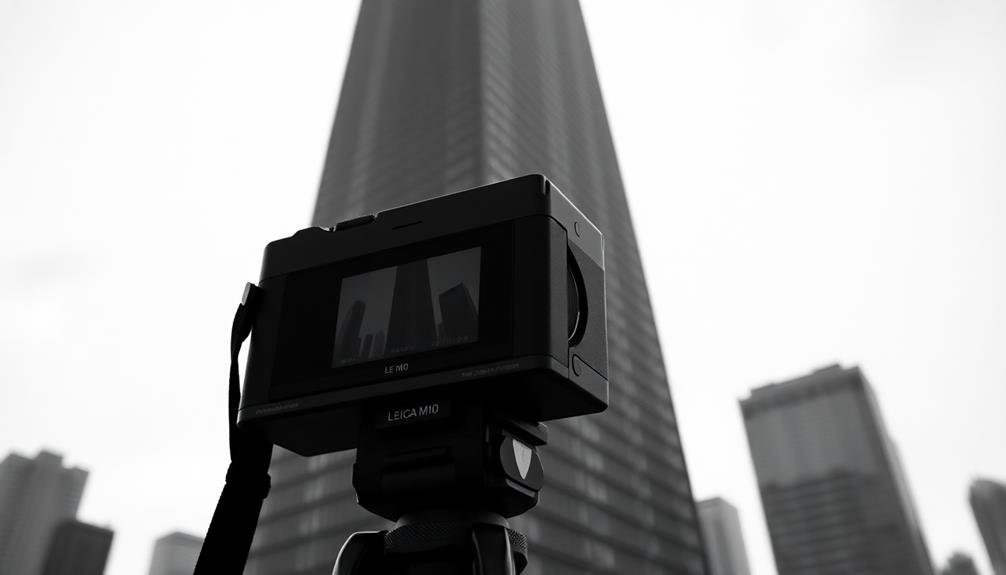
You'll find unparalleled black-and-white imagery with the Leica M10 Monochrom.
This camera excels in capturing the nuances of light and shadow, making it ideal for architectural photography.
Its high-ISO performance allows you to shoot in low-light conditions without compromising image quality, giving you greater flexibility in your architectural visualization projects.
Unparalleled Black-And-White Imagery
The Leica M10 Monochrom frequently stands out as the pinnacle of black-and-white photography in architectural visualization. Its dedicated monochrome sensor captures images with unparalleled clarity, contrast, and tonal range.
You'll find that this camera excels in capturing the intricate details and textures of architectural structures, making it an invaluable tool for professionals in the field.
When you're working with the Leica M10 Monochrom, you'll notice several key advantages:
- Enhanced sharpness and detail due to the absence of a color filter array
- Improved low-light performance, allowing for stunning nighttime architectural shots
- Greater dynamic range, capturing both highlights and shadows with precision
The camera's ability to render subtle gradations of gray tones brings out the essence of architectural forms, emphasizing shapes, lines, and spatial relationships.
You'll appreciate how it captures the interplay of light and shadow, revealing the true character of buildings and spaces. Whether you're photographing modern skyscrapers or historic structures, the Leica M10 Monochrom's black-and-white imagery adds a timeless quality to your architectural visualizations, making it a go-to choice for discerning professionals in the field.
High-Iso Performance Excellence
Many photographers find the Leica M10 Monochrom's high-ISO performance to be truly exceptional. You'll be amazed at how this camera handles low-light situations, allowing you to capture architectural details even in dimly lit environments.
The M10 Monochrom's sensor is designed specifically for black-and-white photography, eliminating the need for color filters and resulting in cleaner, sharper images at high ISO settings. You can confidently shoot at ISO 6400 or even 12800 without significant noise or loss of detail.
This capability is particularly useful when photographing interiors or night scenes, where ambient light is limited. The camera's excellent dynamic range guarantees you'll capture both highlights and shadows with remarkable clarity.
When using the M10 Monochrom for architectural visualization, you'll appreciate its ability to render textures and surfaces with incredible precision, even in challenging lighting conditions.
The camera's high-ISO performance allows you to maintain faster shutter speeds, reducing the risk of camera shake and guaranteeing crisp, sharp images. You'll find that this tool opens up new possibilities for capturing architectural details in various lighting scenarios, from twilight exteriors to dimly lit historical interiors.
Phase One XT Camera System
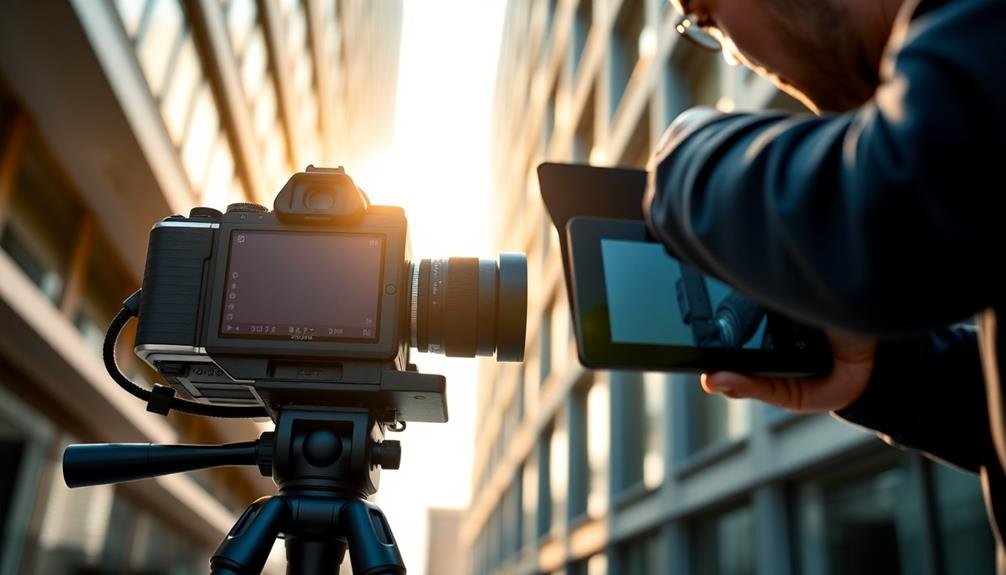
For architectural photographers seeking the pinnacle of image quality, the Phase One XT Camera System stands out as a game-changer. This medium format camera combines portability with exceptional resolution, making it ideal for capturing intricate architectural details.
You'll appreciate its compact design, which allows for easier on-site maneuvering compared to traditional large format systems.
The Phase One XT boasts a 150-megapixel sensor, delivering unparalleled image clarity and sharpness. You'll find that this level of detail is essential when photographing complex structures or creating large-scale prints.
The system's built-in lens movements enable you to correct perspective distortions in-camera, saving time in post-processing.
Here are three key features that set the Phase One XT apart:
- Integrated shift movement for precise composition adjustments
- Electronic shutter for vibration-free captures up to 1/4000s
- Compatibility with high-quality Rodenstock lenses
You'll find the Phase One XT's weather-sealed body particularly useful for outdoor shoots in various conditions.
Its intuitive touchscreen interface streamlines your workflow, allowing you to focus on composition rather than camera settings.
While it's a significant investment, the Phase One XT Camera System delivers unmatched image quality for architectural visualization projects.
Frequently Asked Questions
How Do Weather Conditions Affect Architectural Photography?
Weather greatly impacts your architectural shots. You'll find that sunlight, clouds, rain, and fog can dramatically alter a building's appearance. They'll affect shadows, highlights, and overall mood, so you must adapt your techniques accordingly.
What Lighting Techniques Enhance Architectural Details in Photographs?
You'll want to use a mix of natural and artificial lighting. Employ side lighting to highlight textures, backlighting for silhouettes, and fill lights to reduce harsh shadows. Don't forget to experiment with different times of day.
Are There Legal Considerations When Photographing Buildings?
Yes, there are legal considerations. You'll need to be aware of copyright laws, privacy rights, and property owner permissions. Public buildings are generally okay to photograph, but private properties may require consent. Always respect local regulations.
How Can Post-Processing Improve Architectural Visualization?
You can enhance architectural visualization through post-processing by adjusting lighting, correcting distortions, and fine-tuning colors. You'll also improve detail, remove distractions, and add atmospheric effects. These techniques will elevate your images, making them more impactful and professional.
What Lenses Are Best for Capturing Interior Architectural Spaces?
You'll want wide-angle lenses for interior architecture. Try a 14-24mm or 16-35mm for expansive views. Don't forget tilt-shift lenses for perspective control. A 24mm tilt-shift is ideal for tight spaces and straight lines.
In Summary
You've now got a solid grasp of the top high-resolution photography tools for architectural visualization. Whether you're looking for drones, DSLRs, or medium format cameras, there's something here to suit your needs. Remember, it's not just about the gear; it's how you use it. With these powerful tools at your disposal, you'll be able to capture stunning architectural images that truly showcase your vision and skill.

As educators and advocates for responsible drone use, we’re committed to sharing our knowledge and expertise with aspiring aerial photographers.




Leave a Reply